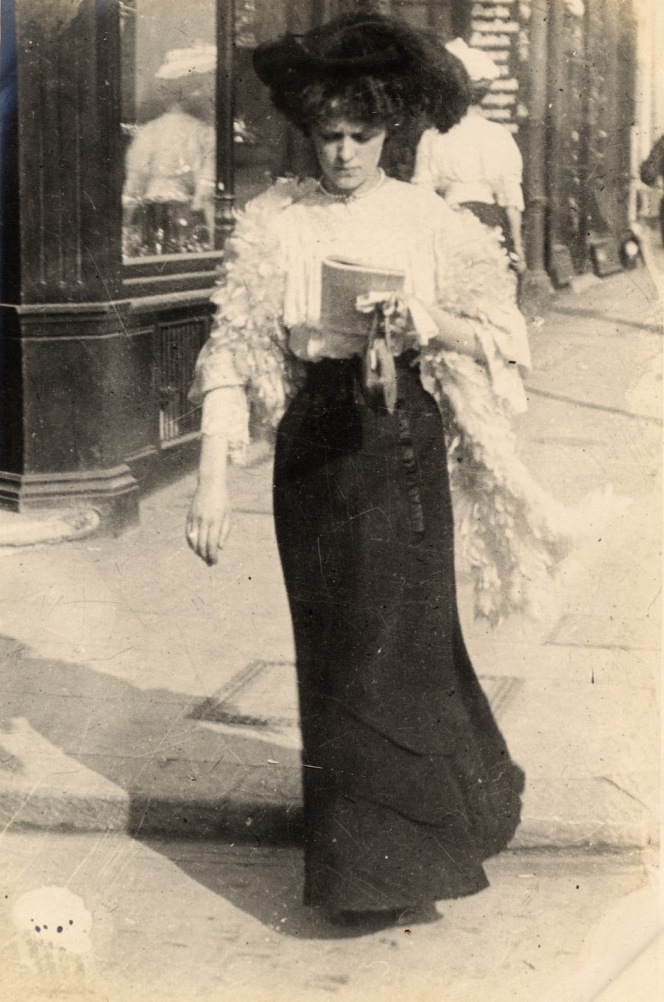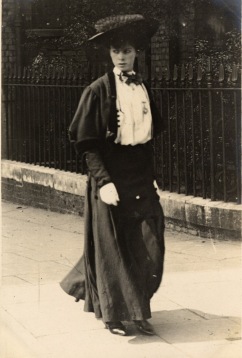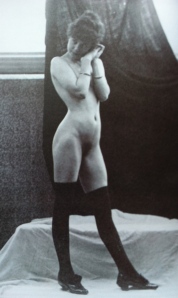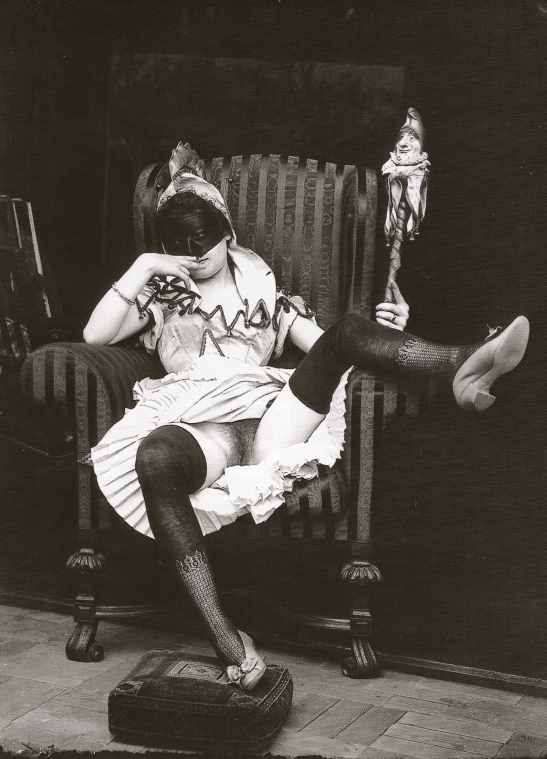The Original Sartorialist

1. Edward Linley Sambourne, ‘Shop Girl’, ca. 1906. Platinum bromide photograph. Collection of the Royal Borough of Kensington & Chelsea Libraries and Arts Service.
While (sadly) perusing the latest in Hollywood gossip a few days ago, I was fairly surprised to see this post on ‘Edwardian Street Fashion’ as photographed by Edward Linley Sambourne at the Daily Mail website. The Daily Mail has in fact been featuring some surprisingly good dress history-related posts lately, as evidenced by featuring an amazing find, a cache of 16th century lingerie (thanks to The Dresser for tipping me on that). But I digress… well, actually, it sort of relates.

2. Edward Linley Sambourne, ‘Cromwell Road’, ca. 1906. Platinum bromide photograph. Collection of the Royal Borough of Kensington & Chelsea Libraries and Arts Service.
Much like the fantastic contemporary Sartorialist, Sambourne captured images of Victorian & Edwardian women on the street (ex. figs. 1-2) – to the eternal gratitude of fashion historians like me. However, what the Daily Mail missed reporting – which their readers would have eaten up – is that Sambourne shot these photos with a hidden camera. That’s right, ol’ Linley was a bit of a voyeur, and the majority of these photos were taken with his subjects unaware. A visit to the source of this article (which the DM of course failed to mention), the wonderful blog of the Royal Borough of Kensington and Chelsea Libraries, reveals a bit more:
Linley Sambourne was by 1906 the chief cartoonist of Punch. He’d had a four decade long career as a cartoonist and illustrator. He was also an enthusiastic amateur photographer. He had taken up photography as an aid to his art. He was a skilled draughtsman, obsessed with getting details correct but he preferred to work with a model. Photography gave him the ability to take pictures of family, friends and professional models which he could use as the basis for his cartoons. He took thousands of pictures in his lifetime most of them for reference purposes including dozens of images of military uniforms, national dress, models in pseudo-classical costumes and fancy dress of all kinds. His wife Marion complained in her diary that photography had become as much an obsession as a hobby… The one difference between Sambourne’s street photography and the pictures taken by modern style bloggers is that for the most part his subjects had no idea they were being photographed. Sambourne used a concealed camera.[1]
His great-grandson, Lord Snowdon (himself a photographer of some note), described seeing the camera (amongst several others) in his youth, on one of his explorations of the wonderful house, 18 Stafford Terrace (now a museum), Sambourne left behind: ‘… one in particular caught my eye. Designed to take pictures at right angles to the direction in which it was being pointed, it perhaps explains the numerous photographs of girls in the archive, who are apparently unaware that their walk to school along Kensington High Street is being recorded for posterity!’[2]

3. Edward Linley Sambourne, ‘Maude Easton’, 20 August 1891. Platinum bromide print. Collection of the Royal Borough of Kensington & Chelsea Libraries and Arts Service.
Now it might be unfair, based on this sneaky habit, to infer that ol’ Linley was a bit of a perv. Except… he kind of was, at least by Victorian/Edwardian standards. It would seem that Linley also photographed his models at his home (when family was away), and sometimes in the studio of a friend, quite nude. Er, the models were nude… the sartorial state of Linley is uncertain. He left behind a wonderfully saucy and sensuous collection of images which are also in the collection of RBKC archives – but which, understandably, they can’t exactly make a family-friendly blog post about! Luckily for you, dear reader, I certainly can write about them here.
Sambourne’s photographs were the focus of the 2001 Leighton House exhibit Public Artist, Private Passions: The World of Edward Linley Sambourne, curated by Reena Suleman and Alison Smith. Two facts of note which make this collection rather significant: Sambourne was a ‘born taxonomist’ as Martin Postle puts it, and meticulously recorded not just the catalogue of his photographs, but the names, addresses, and sittings of his models as well; secondly, he had learned the art of photography from start to finish, making his own prints, and thus enabling him to keep his images private.[3]
As Smith points out in the catalogue for this exhibit, many of the nudes Sambourne photographed were done for modelling purposes for his illustrations. For example, a photograph of frequent model Kate Manning served as the basis for an 1888 illustration for Hans Christen Anderson’s The Little Mermaid.

4. Edward Linley Sambourne, ‘Kate Manning’, 16 April 1888. Platinum bromide print. Collection of the Royal Borough of Kensington & Chelsea Libraries and Arts Service.

5. Edward Linley Sambourne, ‘Line Illustration for Hans Christian Anderson’s The Little Mermaid’, 1888.
Likewise, the Pettigrew sisters, famous models for the Victorian artistic elite (they modelled for Millais as girls, then Leighton, Whistler, Prinsep, Hunt, etc., etc.) posed for Sambourne on several occasions – often enough to cultivate trust, as he ultimately photographed them naked together, ‘including several in which they engage in an energetic mock wresting match.’[4]

6. Edward Linley Sambourne, ‘The Pettigrew Sisters’, 1892. Platinum bromide print. Collection of the Royal Borough of Kensington & Chelsea Libraries and Arts Service.
Thus, although many of these photos can be argued to have an artistic function (some of the Pettigrew shots were used as a model for illustrations for the Dover Street Bathing Club), they were certainly erotically charged.
And some were more than just ‘charged’. Sambourne captured some rather sexually explicit images of certain of his models, and it is hard to imagine they weren’t suggestive of an intimate relationship.

7. Edward Linley Sambourne, ‘Maude Easton with a glass of champagne’, 1891. Platinum bromide print. Collection of the Royal Borough of Kensington & Chelsea Libraries and Arts Service.
Photos of Maud Easton (figs. 3, 7, 8) taken between 1891 and 1893, for example, range from subtly sensuous to graphic displays. Postle explains:
Maud Easton posed nude in a variety of sensual poses, seated in a leather armchair and lying on a table. During the third session she performed a partial striptease holding a champagne glass, Sambourne describing her in his diary that day as a ‘Silly Girl’. A fourth session, on 30 September [1891], included a series of highly erotic photographs of her in a ‘Folly dress’ and a mask, her legs spread wide open. (After the session Sambourne complained of being hindered by the activities of workmen on the roof.) Whether these photographs were made solely for Sambourne’s own private delectation, or shared with male friends, is unknown.[5]

8. Edward Linley Sambourne, ‘Maude Easton in Folly Costume’, 30 September 1891. Modern print from original plate glass negative. Collection of the Royal Borough of Kensington & Chelsea Libraries and Arts Service.
It would be easy to dismiss these images as Victorian porn, however their careful composition belies Sambourne’s artistic eye, and his desire to closely study the range of human emotions for the purposes of his illustrations (though perhaps this latter theory cannot be applied to the images of masked Maude, which are obviously gratuitous, if beautifully composed). We do see his interest in studying poses and expressions in some very amusing portraits he made of himself looking rather silly (figs. 9-11), which were likely meant to aid in his drawing of cartoons.

9. Edward Linley Sambourne, ‘Self-portrait in outdoor coat’, 20 September 1894. Platinum bromide print. Collection of the Royal Borough of Kensington & Chelsea Libraries and Arts Service.

10. Edward Linley Sambourne, ‘Self-portrait in Apron, 19 July 1894. Cyanotype. Collection of the Royal Borough of Kensington & Chelsea Libraries and Arts Service.

11. Edward Linley Sambourne, ‘Self-portrait in swimming costume’, 22 August 1888. Platinum bromide print. Collection of the Royal Borough of Kensington & Chelsea Libraries and Arts Service.
Sambourne’s almost anthropological interest in capturing human expression may have been driven by his voyeuristic tendencies. The result of his quirky nature is a fascinating record of Victorian artistic life, both public and very private. And both his covert street snapshots and his subversive intimate photographs leave an unprecedented sampling of everyday Victorian and Edwardian dress, and undress. I for one am incredibly grateful – it certainly makes my job entertaining, fascinating, and even a little bit scintillating.
 I highly recommend the catalogue of the exhibition Public Artist, Private Passions: The World of Edward Linley Sambourne, which includes essays by Reena Suleman, Alison Smith, Martin Postle, Leoneé Ormond, Jerome McGann, Simon Popple and Colin Harding. It is for sale in the shop of the Linley Sambourne House, which might be worth a phone call rather than ordering it for a small fortune second hand.
I highly recommend the catalogue of the exhibition Public Artist, Private Passions: The World of Edward Linley Sambourne, which includes essays by Reena Suleman, Alison Smith, Martin Postle, Leoneé Ormond, Jerome McGann, Simon Popple and Colin Harding. It is for sale in the shop of the Linley Sambourne House, which might be worth a phone call rather than ordering it for a small fortune second hand.
[1] David Walker, “Street Style 1906: Edward Linley Sambourne’s Fashion Blog,” The Library Time Machine, March 29, 2012, http://rbkclocalstudies.wordpress.com/2012/03/29/street-style-1906-edward-linley-sambournes-fashion-blog/.
[2] Foreword, Robin Simon, ed., Public Artist, Private Passions: The World of Edward Linley Samboure (Leighton House Museum, 2001), 1.
[3] Martin Postle, “Hidden Lives: Linley Sambourne and the Female Model,” in Public Artist, Private Passions: The World of Edward Linley Samboure, ed. Robin Simon (Leighton House Museum, 2001), 20.
[4] Ibid., 21.
[5] Ibid., 25.


Thank you for the post on Lin Sambourne. He’s slowly wriggling his way into Victorian art history, particularly with the book published by Leonee Ormond (I can give you a loan of it if you don’t already have it).
My thoughts on Sambourne are conflicted. I definitely don’t think he was interested in street fashion (sorry DM!), and his late Victorian and Edwardian photographs are definitely born of some sort of licentiousness as far as I’m concerned. He has no respect for boundaries (or moral codes) and photographing his female servants and young girls… Call me cynical, but I can’t pass these as artistic.
However, his posed nudes that he used for illustrative purposes definitely can be classes as artistic photographs, and it is known that he admired Leighton and the Classicism of his pictures. I think he was a more interesting photographer than he was draughtsman. I really like his candid pictures of models (not so much Maude Easton as it’s almost certain that they were up to no good!) but he photographed some models in quite unaffected stances, and these are the most interesting portraits to me.
Anyway, without dissecting the pictures in reference to theories of the naked/nude, theories about photography and the rest, I think it’s nice that you’ve featured Sambourne in a blog post and I can’t wait to read the next one!
Hello darling, thanks for your comment! I was hoping you would as you know much more about this subject than I do.
No, I don’t think he was out there photographing these women because he was trying to record fashion. I think he enjoyed playing with his sneaky camera and liked pretty girls. If you look at the RBKC library post, there are also some shots of women in bathing costume which I’m sure were just for his own fancy. But for the purposes of fashion history, we can mix a little gratitude with our disdain for his invasive behaviour.
Even though they were ‘up to no good’ as you say, I still find that picture of Maude quite beautiful in terms of its composition and framing.
You are completely right about the street shots, but they serve as interesting historical documents nonetheless. I like some of the shots of Maude Easton. Some are really quite shocking (even today), and probably more so because he brought her into his family home and photographed her there. Shock horror! Anyway, I have to say that I love the first photo in this blog. The face that it is a sneaky snap adds to its charm, and it’s really quite an interesting shot when you think about the shop girls of the 1890s and the big thing about women walking about the streets on their own.
Someone needs to write something about masked models and Sambourne because he tends to cover their faces with props quite often. You should write it — you have such a great way of writing. Anyway, back to the thesis!